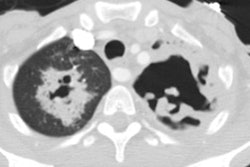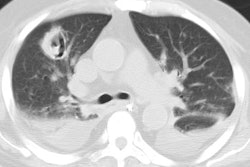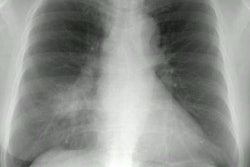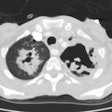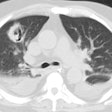Mycoplasma:
Clinical:
Mycoplasma pneumoniae is the most important cause of atypical pneumonia. Mycoplasmas are the smallest free-living organisms and they are similar to bacteria in that they contain DNA, RNA, and energy generating ribosomes, however, unlike bacteria the organism is unable to synthesize a rigid cell wall (Click here for separate discussion regarding Mycoplasma classification). M pneumoniae accounts for 10-15% of cases of community acquired pneumonia, but the prevalence is much higher (about 50%) for specific groups- such as military recruits [2]. The disease has a winter/fall predominance and is highly communicable usually affecting closed populations and children (age>6y). Most infections produce a tracheobronchitis and pneumonia occurs in only 3-10% of infected individuals. Patients complain of constitutional symptoms such as headache, malaise, and myalgias; and have a non- to minimally productive cough. Patients are cold agglutinin positive (M. pneumoniae is the most common respiratory cause of cold agglutinin production, but this test is non-specific). Prognosis is good. Extrapulmonary manifestations are uncommon, but include hemolytic anemia, thrombocytopenia, disseminated intravascular coagulation, pericarditis, myocarditis, transverse myelitis, and gastroenteritis.X-ray:
The CXR typically reveals patchy, non-segmental alveolar infiltrates (bronchopneumonia pattern) especially in a lower lobe (50%) distribution. The infiltrates are bilateral in 10-40% of cases. Small effusions are found in up to 20% of cases, but other authors indicate effusion is uncommon [2]. Fine interstitial infiltrates (reticular pattern) are usually seen early in the course of the infection [2]. Unilateral segmental/ lobar consolidations may also be seen.Findings on CT include areas of consolidation, ground-glass opacity, bronchial wall thickening, and patchy centrilobular nodules (indicative of bronchiolitis).
REFERENCES:
(1) AJR 2000; Reittner P, et al. Mycoplasma pneumoniae pneumonia: Radiographic
and High-resolution CT features in 28 patients. 174: 37-41
(2) Radiol Clin N Am 2005; Tarver RD, et al. Radiology of community-acquired pneumonia. 43: 497-512
